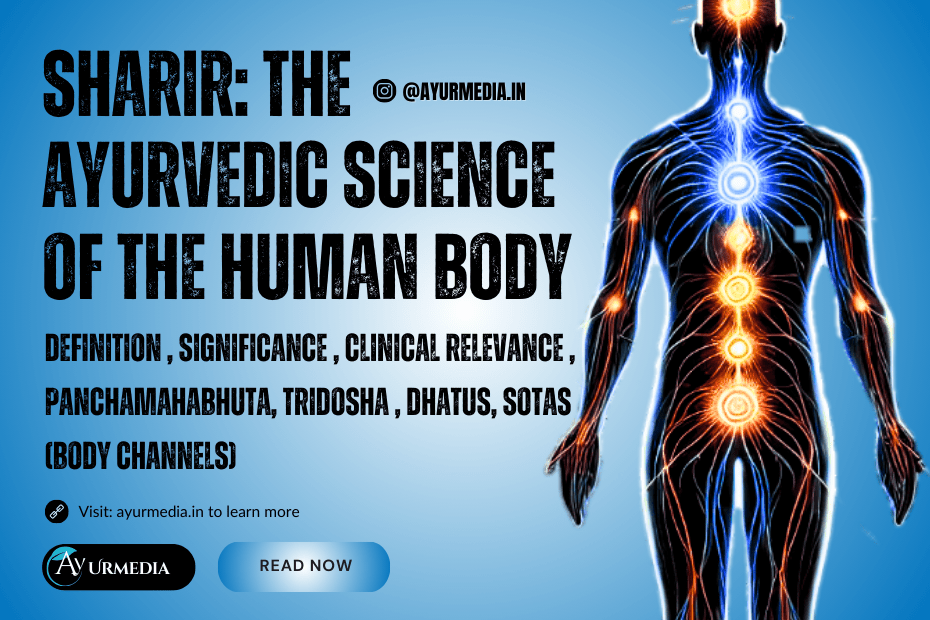What is Ayurveda? meaning of Aayu
Ayurveda is a “Sanskrit word”, it is composed of two words “Aayu + Veda”. Where ayu means life (Composition of body, senses, mind, and soul) and Veda means science which describes Aayu (Life).
Therefore, the Veda (Science) which describes the Aayu (Life) is Ayurveda. “in Simple words, Ayurveda means the science of life and longevity or knowledge of life and longevity”. Therefore, those who wish for longevity should learn Ayurveda.
What is Aayu?
Shloka – शरीरइंद्रिय सत्व आत्म संयोगो आयु:।
According to Ayurveda the composition of body, senses, soul, and mind is Aayu or the composition of the Panchmahabhuta (five elements of nature) earth (Prithvi), water (Jala), fire (Tejas), wind (Vayu) and space (akasha) is Aayu. Therefore, Ayurvedic Panchakarma Treatment is based on treating the five elements these five elements are also considered the constituents of Tridosha (i.e Vata, Pitta, and Kapha).
There are four types of life span.
- Hit Aayu (Good life span Due to good deeds)
- Ahit Aayu (Bad Life span due to bad deeds)
- Sukh Aayu (Happy Life span/devoid of physical and mental disease
- Dukh Aayu ( Unhappy life span/state of suffering/Sick life)
Definition of Ayurveda
The Sanskrit verses :
हिता हितं सुखं दुखम आयुस्तस्य हिता हितं
मानं च तच्च यात्रोक्तम आयुर्वेद सः उच्यते ।
The Veda (Science) which describes the four type of life span Hit Aayu (Good life span Due to good deeds) Ahit Aayu (Bad Life span due to bad deeds). Sukh Aayu (Happy Life span/devoid of physical and mental disease and Dukh Aayu ( Unhappy life span/state of suffering/Sick life span) and what is good and bad for these four types of Aayu is known as Ayurveda.
Aim of Ayurveda
Ayurveda has two main objectives.
- Protecting the health of a healthy person and helping them to attain Virtue, Purpose or Wealth, Pleasure, and Salvation.
- To heal the illness of the ill.
8 Branches of Ayurveda
There are eight branches of Ayurveda therefore it’s also called “Ashtanga Ayurveda” (8 branches Ayurveda).
- Kayachikitsa (General Medicine)
- Balachikitsa or Kaumarbhritya (Obstetrics/pediatrics)
- Graha Chikitsa (Psychiatry)
- Shalakya Chikitsa (ENT & Cephalic Disease)
- Salya Chikitsa (Surgery)
- Visha Chikitsa (Toxicology)
- Rasayana Tantra (Rejuvenation Therapy)
- Vrish Chikitsa or Vajeekarana (Aphrodisiac Treatment)
History of Ayurveda
Ayurveda is 5000 years old ancient science of medicine1Mishra L, Singh BB, Dagenais S. Ayurveda: a historical perspective and principles of the traditional healthcare system in India. Altern Ther Health Med. 2001;7(2):36-42., which has emerged on the earth for longevity. The true history of this ancient science begins from the time of the Vedas, the sacred texts. Ancient mythology says that the concept of the essence of this sacred text was revealed by the creator of the world Lord Brahma.
There are four Vedas (sacred texts).
- Rigveda
- Yajurveda
- Samaveda
- Atharvaveda
Ayurveda is the subdivision of the Atharvaveda. The Vedas preach the philosophy of life. The Atharvaveda has principles of treatment, on which this sacred book is based.
According to the classics, Ayurveda was first revealed by the Lord Brahma himself. Lord Brahma affirmed it as Trisutras in which the entire systematic knowledge is described. Ayurveda is also called Trisutra.
These are the Trisutras.
- Hetu (Cause of disease)
- Linga (signs and symptoms)
- And Aushadha (Medicine).
This ancient science is preached in two texts called Samhita.
- Charak Samhita (Main Book of General Medicine) Written by Maharshi Charaka.
- Sushrut Samhita (Main Book of Surgery) Written by Maharshi Sushruta.
Charaka Samhita
The preacher of Charaka Samhita is Lord Aatreya. Maharshi Charaka was his disciple who collected the teachings of Lord Aatreya and wrote a treatise later known as Charaka Samhita.
Maharshi Charak is also regarded as the father of Ayurveda (Medicine).
Charak Samhita (Main Book of General Medicine) Written by Maharshi Charaka It has 8 Sthanam (Parts) and 120 chapters which are originally written in the Sanskrit language.
The 8 Sthanam of Charaka Samhita are.
- Sutrasthanam
- Nidansthanam
- Vimansthanam
- Sharirsthanam
- Indriyasthanam
- Chikitsasthanam
- Kalpsthanam
- Sidhi Sthanam
Sushruta Samhita
The preacher of Sushruta Samhita is Lord Dhanvantari (The God of Medicine). Maharishi Sushruta was his disciple who collected the teachings of Lord Dhanvantari and wrote a treatise later known as Sushrut Samhita.
Maharishi Sushruta is also regarded as the father of Indian surgery.
Sushruta Samhita (Main Book of Surgery) Written by Maharshi Sushruta It has 6 Sthanam (Parts) and 120 chapters which are also written in the Sanskrit language.
The 8 Sthanam of Sushruta Samhita are.
- Sutrasthanam
- Nidansthanam
- sharirsthanam
- Chikitsasthanam
- Kalpsthanam
- And Uttar Tantra
See Also: Ayurvedic Dictionary Sanskrit with translation (Online)
Thanks for reading this article. If you have any suggestions or queries associated with this subject, let me know in the comment section since I’m here to enhance it.
References
- 1Mishra L, Singh BB, Dagenais S. Ayurveda: a historical perspective and principles of the traditional healthcare system in India. Altern Ther Health Med. 2001;7(2):36-42.



